One of the mechanically interesting guns that is really widely available in the US for a great price (or was until very recently, it seems) is the Russian M1895 Nagant revolver. It was adopted by the Imperial Russian government in 1895 (replacing the Smith & Wesson No.3 as service revolver), and would serve all the way through World War II in the hands of the Red Army.
As with its other standard-issue arms, the Russian government intended to manufacture the M1895 revolvers domestically. However, when the Nagant was officially adopted the major Russian arsenals were already working at capacity to make the relatively new M1891 rifle, so the first 20,000 revolvers were made by Nagant in Liege, Belgium. In 1898 space had been freed up to start production at the Tula arsenal, where they would be made until 1945 (Ishevsk put the Nagant revolver into production as well during WWII).
The common version available in the US today is a 7-shot, double action revolver chambered for 7.62x38mm. That cartridge is a very long case with the bullet sunk down well below the case mouth. The cylinder of the Nagant cams forward upon firing, allowing the case mount to protrude into the barrel and seal the cylinder gap, thus increasing muzzle velocity slightly. This also allows the Nagant to be used effectively with a suppressor, unlike almost all other revolvers (in which gas leaking from the cylinder gap defeats the purpose of a suppressor).
The Nagant’s 7.62x38mm cartridge pushes a 108 grain jacketed flat-nose projectile at approximately 850 fps (I believe a lighter 85-grain load was also used by the military later, but I haven’t fired any of it), which puts it roughly between .32 ACP and .32-20 ballistics. Not a hand cannon by any stretch, but fairly typical for the era (the 8mm Nambu and 8mm French revolver cartridges were both pretty similar in performance to the 7.62mm Nagant).
As far as being a shooter, the Nagant is mediocre, but reliable. The grip and sights are acceptable (but not great), and the cylinder loads and unloads one round at a time. The low pressure round doesn’t stick in the cylinder, at least. The worst part for a recreational shooter is the trigger, which is very heavy in double action. Single action is also heavy, but very crisp. Recoil is mild, and not uncomfortable at all. The design was simple and effective, and really a good fit for the Red Army and WWII fighting conditions.
Videos
Manuals
First up, a 1901 armorer’s manual (14 pages, truncated):
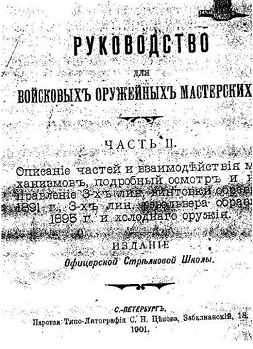
Note that the revolver is often referred to as a “3-line revolver” – the “line” is an archaic Russian unit of measurement equal to one tenth of an inch (or 2.54mm). You will also see the Mosin-Nagant rifle described as a 3-line rifle; this is equivalent to the US designation of “Rifle, Cal. 30”.
Anyway, next up is a document entitled “Instructions for Receiving and Making 3-Line Revolvers M1895” (typed, no pictures, and dated 1927):
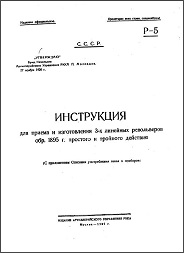
Following that, a 67-page section of a technical repair manual for the M1895 (and the TT33 automatic pistol), clipped out from a larger document. I don’t have a date for this one, but it must be post-1930, since it includes information on the Tokarev pistol:
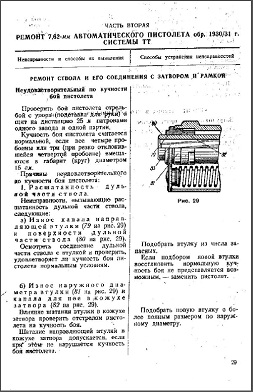
Finally, we have a trio of operators’ manuals covering both the Nagant revolver and the Tokarev automatic. The 1940 and 1950 editions are truncated and do not include all the Tokarev information (and the 1950 has a couple torn pages), and the 1954 edition is complete.
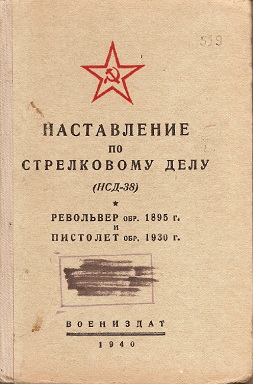
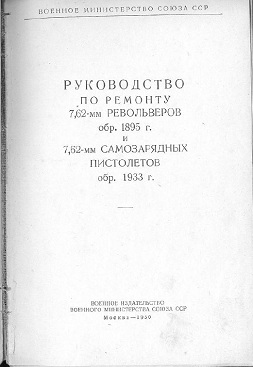
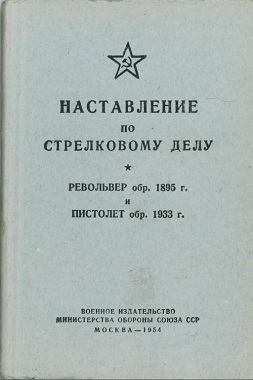
Additional Resources

You could make the Nagant into an automatic revolver, by using the ejector rod to act as a gas piston perhaps. Remove the swivel mount for the ejector rod and drill a hole through the rear of the frame behind the cylinder, behind the hole for the ejector rod in the cylinder pin. So when the rod was inserted it would come into contact with the front lower side of the hammer via the new hole, push it and it would cock the hammer. Attach a gas tube to the front of the cylinder pin, this would hold the ejector rod as a gas piston. Put a spring around the rod which would compress by it’s end piece against the cylinder pins front, drill a hole through the new gas tube at a point forward of the rods front when the hammer is fully cocked with the rod resting against it. Drill a hole through the underside of the barrel, at a point forward of the rods end when the spring is fully uncompressed this would connect with the gas tube. Attach a peacemaker style ejector rod between the barrel and gas tube, fit a silencer.
The roots of the 1895 go back about 20 years previous, with various designs by Nagant and Pieper, descendants of the French “System Delvigne” from 1871. Some were “gas seal”, some weren’t, but they all worked the same way. The basic design was quite widespread in Europe.
Though much is made about the “gas seal”, if you look at how the sliding-cylinder system works, it centers each chamber with the back of the barrel. No index errors, no “bad chambers”, no sloppy latch, no forcing cone, no cylinder gap, no topstrap erosion… the Soviet pistol teams made good use of the design’s advantages, back in the day.
And in the modern world where people get fingers customized by weird grips on .480 Rugers and .500 Smiths, no “angel wing” blasts out the side.
Also, though the 1895 used smokeless powder, its predecessors used black powder and corrosive primers. The “gas seal” mechanism kept all the residue in the barrel; just pop out the cylinder, swab the barrel, and you were good to go. Unlike the rather involved cleaning procedures for most revolving pistols of the black powder era…
Though probably 95% of all Pieper-pattern revolvers were Model 1895 Nagants, other manufacturers also made them in .38 and .44 caliber, and with swing-out cylinders.
Finally, note the swinging breech-block arrangement that preloads the cartridge forward in its chamber. Though case set-back wasn’t an issue with the modest 3-line cartridge, the swinging breech-block and sliding cylinder would eliminate the problem for some of the hotter cartridges or bottlenecked cases.
There are pictures of many of the Pieper variants on the littlegun.be site. And a thread here: http://www.weaponsguild.com/forum/index.php?topic=46861.0
I like how all the internet gun experts bash the gun. It was an effective military defensive sidearm that stopped many an agressor, and probably put down a few of those that opposed at close range. The revolver is well made, durable, light and handles well. The military surplus loading is adequate although a bit small at .30 Cal. I would not feel under armed with one and 7 shots it does not leave one wanting. The only downside is the slow load/re-load, the heavy DA trigger pull, and the fact if you use surplus you need to clean the bore immediately with windex or some other ammonia based cleaner. The exact procedure can be found by Google. All and all it is one of my personal favorites and has old world Chamelot-Delvigne lines making it look like a classic. I carry mine in the woods with Mil-Surp 7.62X38r and I am confident I can ward off most 2 & 4 leg predators with the exception of a large bear. Follow this dissasembly to clean the internals and grease all the parts lightly with EWG Extreme Weapons Grease after removing cosmoline and dirt: https://www.youtube.com/watch?v=gBvHXR3Dyek Do NOT use pliers on the mainspring! After cleaning and greasing your trigger pull will be greatly improved!
What a fantastic revolver! I just bought my third one with a manufacture date of 1927. I have had more out and out fun with my Nagants than any of my other handguns. This new one groups into four inches at 15 yards, DA with Fiocchi ammunition. Yes, the trigger pull is hard but it makes you an “expert” with any other DA revolver. I cut off the cases at the cannelure with a small Vermont American pipe cutter, chamfer the mouth of the case and load it with 2.3 grains of Red Dot and a 71 grain FMJ .32 ACP bullet. You loose the gas seal but it is a fun, light load, accurate out to 25 yards. I have been using the same Fiocchi cases since 2007. As a matter of historical significance, the weapons used to murder the Tsar and his family in July, 1918 were a pair of Mauser broomhandles, two Colt automatics, two Belgian Brownings, an S&W revolver and seven Nagant M1895s (see page 181, Rappaport: The Last Days of the Romanovs) I don’t doubt that in some backwater town in Russia, the local cops still carry Nagants.
I own one and am quite fond of it. It’s pretty rugged – but quite rough finish wise. It functions flawlessly and is acceptable in the accuracy department.
There is something pretty neat about holding a piece of history….
I just received a target model MTs-4 Nagant revolver as a present. It is a 1943 manufacture Tula with the longer, heavier target barrel, adjustable front and rear sights, target grip, and has been turned into a single action only version. The target grip took some getting used to, but the weapon shoots very accurately, and is fun to handle at the range. I use the Fiocchi light loads, and I have found it very accurate. Has anyone ever reviewed the target model? I have not been able to find a review anywhere.
Here is another classic military handgun that saw extensive use during both World War 1 (1914-1918) and World War II (1939-1945). I first
learned of the 1895 Nagant while viewing the 1978 T.V. mini series “Holocaust.” Polish Jews inside the Warsaw Ghetto in Nazi occupied Poland
on April 19th, 1943 rose up against the murderous SS and fought with brutal resistance to the death! The alternative was being rounded up
at gunpoint and loaded into railroad boxcars and cattle cars destined to Treblinka. The 1895 Nagant, like the Model 1891 and later Model
1891/30 Mosin-Nagant bolt action rifle, was also unfortunately the preferred murder weapon of the original Soviet Secret Police or Cheka
established by Lenin in 1918, and followed by the NKVD under Stalin. Personally I would choose a K-Frame Smith and Wesson Model 10 .38
Special Military and Police revolver as my sidearm. Of course, the .38 Special probably wasn’t readily available in Poland, including
Eastern Europe, and Russia during this time.
Where can I buy an original 7.62 mm cylinder for an 1895 Nagant?
How do I adjust the front site post on my sons 1895 Nagant pistol?
I have a 1939 m1895 and want to know how to tell if it’s a replica or original piece any help would be appreciated,
Clavel
My brother has and old (and somewhat pitted) one of these pistols. His has 6 chambers rather than the usual 7 does this make it older ??
Regards
|Glenn
Mine was made like an old tractor. If anything ever broke or misaligned, you fixed it with a hammer.